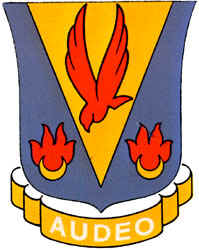
324th Fighter Group
The first OTU in the Millville area was the 33rd Pursuit Group at Philadelphia Airport. Originally sent to provide air defence of the region, it became the parent group which contributed cadre to the 324th Fighter Group and the Philadelphia Air Defence Wing. Through the OTU system the USAAF had created all of new combat units required by the end of 1943, but a constant flow of new pilots was needed to replace those captured, killed in action, or rotated back to United States. Most of the training bases in the United States discontinued OTU training and switched their training emphasis to Replacement Training Units (RTUs).
|
Squadron Insignia: |
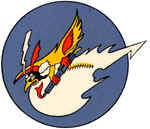 |
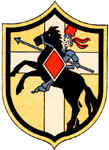 |
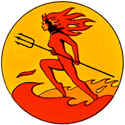 |
|||
| 314th FS: | 315th FS: | 316th FS: | ||||
| Plane Identification codes: | #'s 10-39 | #'s 40-69 | #'s 70-99 | |||
|
Hawks |
Crusaders |
Stories about the 324th Pilots To Tell the Tale
Original Roster of the 316th Fighter Squadron (1942)
A small reference in the booklet "P-40 Warhawk Aces of the MTO" indicates that Pilots of the 79th and 324th Fighter Groups ferried new P-40's across Africa from the assembly plants at Accra and Lagos, in Nigeria, via Fort Lamy in French Equatorial Africa to depots in Cairo, prior to entering combat operations. (Meaning they had been shipped in crates and not flown from a carrier).
Source for following: http://www.web-birds.com/12th/324/324th.htm
Homepage: http://www.324thfighter.org/324home/html/home-2.html
The squadrons went forward to go into combat, the 314th flying with the 57th Group, while the 315th and the 316th joined forces with the veteran 79th pilots. The Hawk squadron proved its mettle in the Cape Bon massacre shooting down over one third of the total bag of 74 German planes. Fame came to the Crusaders as Capt. Bill Gatling, then a flight officer, became the first fighter pilot in the Mediterranean theater to sink a destroyer. While providing cover for bombers the Hell's Belles flyers tangled with the Luftwaffe, destroying eight, probably destroying six and damaging one while four of the 316th flyers failed to return. Meanwhile at Kabrit the group headquarters had been joined by the 315th and this part of the group travelogue included trips to Cairo, and the Holy Land.
The 314th Fighter Squadron shares its heritage with the 315th and the 316th Fighter Squadrons. All three were created by cadres from the 33rd Fighter Group-a cadre from the 58th Fighter Squadron formed the nucleus of the 314th, the 59th Fighter Squadron provided the nucleus of the 315th and the 60th Fighter Squadron formed the nucleus of the 316th.. Earlier, the 33rd Fighter Group had been created in the same fashion by cadres from the 8th Pursuit Group. It's interesting to note that in January 1942 orders concerning the 33rd Group and its squadrons still referred to them as "Pursuit" units. It was not until July 6, 1942 when orders were cut establishing the 324th that the pursuit designation was dropped in favor of "Fighter" units.
In the latter part of November 1942 the squadron was ordered overseas. From Baltimore, the pilots were flown from Washington to Miami aboard commercial aircraft. There they boarded U. S. Air Corps C-54's, which took them via Puerto Rico, Trinidad, British Guiana, Belem to Natal, Brazil. There the flight across the Atlantic Ocean to Africa started. The first landing was Ascension Island.
Most pilots stayed in Accra for several days waiting for crated P-40's to arrive by ship at the port of Lagos, Nigeria. While the planes were being assembled, the pilots spent considerable time on the nearby beaches, some of the most beautiful that any of them had ever seen. When the ground crews began to assemble the P-40's, the pilots were transported to Lagos to slow-time the aircraft for a few hours before starting the journey to the Mediterranean area
The P-40's did not have sufficient navigational equipment for the journey so they were led by a bomber with a navigator on board. This was not always successful as on occasion even the navigator got lost! Every pilot was then on his own to find a place to land.
Most of the refueling stops were operated by Pan American Airways, which had only recently established the trans-African air route. The first stop was Kano, in northern Nigeria. This flight was a tense one as it was over dense jungle. If a plane went down enroute it is doubtful the pilot would be rescued as the jungle canopy would swallow up any trace of a downed aircraft.
After Kano several airfields in sub-Saharan Sudan and Egypt were used before arriving at Khartoum, Ft. Lamy (famous as a French Foreign Legion base), Maiduguri, El Geneima and El Fashir depending upon weather and fuel supplies at these bases. Supplying fuel to these fields was a logistical problem.
At Khartoum the P-40F's 50-caliber wing guns were loaded with ammunition for the flight to the Cairo area or Palestine. If Gen. Montgomery's Eighth Army had not been able to hold the line at El Alamein we would go to Palestine and it might be necessary to fight our way through. Fortunately, Gen. Montgomery did hold the line, and Rommel's Afrika Corps had just begun its long retreat across the western desert.
We landed at Heliopolis Airport located just south of Cairo. The refueling stop for this leg of the trip was either Wadi Halfa or Luxor. These airfields were operated by the RAF. The refueling operation at Wadi Halfa was very interesting. Gasoline came in five gallon cans similar to the old lard cans. It is believed the fuel came by riverboat to the nearby port and was then transported by camel to the airfield. The RAF used what they called a "bowser" to pump the gas into the planes. It resembled the old hand pumps used by American fire departments years ago. Across the top of the bowser tank a large chamois skin was stretched to filter out dirt and water. The RAF GI's gashed the tins with a hatchet or knife and tossed the cans up on top of the chamois skin to drain
Several days were spent in the Cairo area waiting for the ground echelon to arrive. A few pilots were hospitalized with malaria, no doubt picked up while in Accra or Lagos. Others made more ferry flights from Lagos. Most of the P-40's were destined for the 57th Fighter Group and the 79th Fighter Group to replace their combat losses as well as to modernize their fleets.
Following from: http://mywebpages.comcast.net/blueyonder316/Gatling.htm
The ground echelon which consisted of Administrative, Maintenance and Supply personnel, Medics, Cooks, and Meat Cutters, traveled West by train. The ground echelon took the boat trip from San Francisco, CA heading for destinations unknown.
The air echelon, consisting of 27 pilots and 1 flight surgeon, headed south to West Palm Beach / Miami, Florida. Then transported by Pan American Airways aircraft through British Guiana, Natal / Brazil, and the Ascension Island to Accra, Ghana, West Africa. They were then transported by British aircraft to Lagos, Nigeria to pick up their P-40 Warhawks and fly them across Africa.
Four to seven squadron pilots at a time followed twin-engine A-20 aircraft , this was done for navigation purposes. They traveled across Nigeria, Chad, and the Sudan to Khartoum where they left the A-20 aircraft.At this point, the pilots followed the Nile River north to Ciaro, Egypt, and then flew to El Kabrit which was southeast of Cairo on the Sues Canal. That is where the air and ground echelons joined forces again in their march to North Africa.
While at El Kabrit, the pilots dropped a couple of practice (no demolition, color marker mostly) bombs and flew a couple of "Shadow Gunnery" missions.During a Shadow Gunnery mission, the wingman or buddy pilot would fly straight and level over the sunny, hot desert at about 500 feet, casting a moving shadow of his P-40 on the ground below.The other pilot would make "live Ammo" fireing passes at the moving shadow of his buddies aircraft. This was about the first time that most of the new, original pilots in the squadron had fired the six 50 caliber machine guns that were mounted in the wings of their P-40 Warhawks. The pilot fireing the guns could easily see the dust fly when the bullets hit the hot sand of the desert, and determine whether he was hitting the moving shadow target or not.
In April 1943, pilots of the 315th Fighter Squadron started moving up 3 or 4 at a time, to the combat zone in Tunisia. Joining with the 316th Fighter Squadron, which was attached to the 79th Fighter Group, these pilots would now go through Combat Indoctrination, which was supervised, actual combat flying. After all pilots had gone through this indoctrination, the squadron was considered "Combat Ready". It was on one of these missions that Gatling got his direct hit on the enemy destroyer
| Air Forced Assigned To: | 9th AF (Oct '42 -July '43) | |
| 12th AF (July '43 - End WWII) | ||
| Stations Flown From: |
EL Amiriya, Egypt (Dec '42 - Feb '43) WEDNESDAY, 23 DECEMBER 1942, EASTERN MEDITERRANEAN (Ninth Air Force) The 324th Fighter Group and its 314th and 316th Fighter Squadrons with P-40s establish HQ at El Amiriya, Egypt upon arrival from the US. The group will fly its first combat mission on 26 Mar 43. Combat training conditions at LG-91 were terrible. It seemed more effort was expended surviving rather than training. Sand got into everything. Maintenance crews plugged up every opening of the P-40 but sand still won. The carburetor air intake of the P-40 was equipped with a filter screen. It was kept closed while the aircraft was on the ground and for takeoffs and landings but sand still managed to get in the engine. The crowning blow to force us out of LG-91 was a sand storm that lasted over 48 hours. On February 1, 1943 the 314th moved to El Kabrit located next to the Suez Canal to continue combat training, dive bombing and strafing enemy targets. |
|
|
El Kabrit, Egypt (Feb '43 - Jun '43) TUESDAY, 2 FEBRUARY 1943, EASTERN MEDITERRANEAN (Ninth Air Force), HQ 324th Fighter Group and it's 314th Fighter Squadron with P-40s transfers from El Amiriya, Egypt to El Kabrit, Egypt. WEDNESDAY, 3 FEBRUARY 1943, EASTERN MEDITERRANEAN (Ninth Air Force),, The 316th Fighter Squadron, 324th Fighter Group with P-40s transfers from El Amiriya, Egypt to El Kabrit, Egypt. MONDAY, 8 MARCH 1943, The 314th Fighter Squadron, 324th Fighter Group with P-40s transfers from El Kabrit, Egypt to Libya and is attached to the 57th Fighter Group to gain experience.
MONDAY, 15 MARCH 1943, EASTERN MEDITERRANEAN (Ninth Air Force) The 316th Fighter Squadron, 324th Fighter Group with P-40's transfers from El Kabrit, Egypt to Libya. MONDAY, 29 MARCH 1943, The 315th Fighter Squadron, 324th Fighter Group with P-40's arrives at El Kabrit, Egypt from the U.S. WEDNESDAY, 14 APRIL 1943, The 314th, 315th and 316th Fighter Squadrons, 324th Fighter Group with P-40's transfer from Libya to Tunisia. SUNDAY, 18 APRIL 1943, EASTERN MEDITERRANEAN (Ninth Air Force) Off Cap Bon, 46 P-40F's of the 57th Fighter Group's three squadrons (64th, 65th and 66th Fighter Squadrons) and the attached 314th Fighter Squadron, 324th Fighter Group, plus 11 Spitfires of the RAF 92 Squadron flying top cover, take off to patrol. At approximately 1800 hours, they spot 2 Bf 109's and an armada of 65 Ju 52/3m transports heading back to Sicily for more supplies. The transports are in three great vees, covered by 16 Bf 109's and Mc 202's and 5 Bf 110's. The 64th Fighter Squadron and the RAF Spitfires stay high; the remaining 3 squadrons of P-40's attack the Luftwaffe formation and down 24 Ju 53/3m's and 16 fighters; another 35 Ju 52/3m's crash along the coast. |
||
|
Kairouan, Tunisia (Jun '43) WEDNESDAY, 2 JUNE 1943, EASTERN MEDITERRANEAN (Ninth Air Force) HQ 324th Fighter Group and it's 315th and 316th Fighter Squadrons with P-40's transfer from an unknown location in Tunisia to Kairouan, Tunisia. |
||
|
El Haouaria, Tunisia (Jun '43 - Oct '43) FRIDAY, 18 JUNE 1943, EASTERN MEDITERRANEAN (Ninth Air Force) HQ 324th Fighter Group and it's 314th, 315th and 316th Fighter Squadrons transfer with P-40's from Kairouan, Tunisia to El Haouaria, Tunisia |
||
| Menzel Heurr, Tunisia (Oct '43) | ||
| Cercola, Italy (Oct '43 - May '44) | ||
| Pignataro Maggiore, Italy (May '44 - June '44) | ||
| Le Banca, Italy (June '44) | ||
| Montalto Di Castro, Italy (June '44 - July '44) | ||
| Corsica (July '44 - Aug '44) | ||
| Le Luc, France (Aug '44 - Sept '44) | ||
| Istres, France (Sept '44) | ||
| Amberieu, France (Sept '44) | ||
| Tavaux, France (Sept '44 - Jan '45) | ||
| Luneville, France (Jan '45 - May '45) | ||
| Stuttgart, Germany (May '45 - End WWII) | ||
| Campaigns Flown in: | Tunisia | |
| Sicily | ||
| Naples-Foggia | ||
| Anzio | ||
| Rome-Arno | ||
| Northern France | ||
| Southern France | ||
| Rhineland | ||
| Central Europe | ||
| Awards Won: | Distinguished Unit Citation: North Africa and Sicily, March - July '43 | |
| Distinguished Unit Citation: Cassino, 12 - 14 May '44 | ||
| French Croix de Guerre with Palm | ||
| Victory Claims (in Air): | Destroyed: | Probable: | Damaged: | |||
| 67 | 15 | 30 | ||||

314 Fighter Squadron
| Name | Rank | Squadron | Date | Theater | Victories |
| AUSTIN HAROLD | 1st Lt | 314FTR | 02-22-1945 | European | 0.5 |
| BERLIN ALPHEUS F | 1st Lt | 314FTR | 12-25-1944 | European | 0.25 |
| BORO WILLIAM B | 2nd Lt | 314FTR | 02-22-1944 | Mediterranean | 1 |
| D'ANTONI ANDREW A | 1st Lt | 314FTR | 07-04-1943 | Mediterranean | 1 |
| DAHLSTROM KENNETH E | 1st Lt | 314FTR | 12-25-1944 | European | 0.25 |
| DEARDON RUSSELL W | 1st Lt | 314FTR | 07-03-1943 | Mediterranean | 1 |
| DUFFEY RICHARD E | 2nd Lt | 314FTR | 04-18-1943 | Mediterranean | 5 |
| KIRK THOMAS M | 2nd Lt | 314FTR | 02-19-1944 | Mediterranean | 1 |
| KIRK THOMAS M | 2nd Lt | 314FTR | 02-22-1944 | Mediterranean | 1 |
| KRAUSE LESTER L | Captain | 314FTR | 07-10-1943 | Mediterranean | 1 |
| MAY HARRY C JR | 1st Lt | 314FTR | 02-22-1945 | European | 1 |
| MCCLINTIC GEORGE V | 1st Lt | 314FTR | 04-09-1945 | European | 1 |
| MILLER JOSEPH A | 1st Lt | 314FTR | 04-09-1945 | European | 1 |
| MORGAN PHILANDER D JR | 2nd Lt | 314FTR | 02-22-1945 | European | 3 |
| O'PIZZI PAUL T JR | Captain | 314FTR | 07-04-1943 | Mediterranean | 1 |
| O'PIZZI PAUL T JR | Captain | 314FTR | 07-08-1943 | Mediterranean | 1 |
| POTTER WILLIAM C | 2nd Lt | 314FTR | 04-09-1945 | European | 0.5 |
| POWERS MACARTHUR | 2nd Lt | 314FTR | 04-18-1943 | Mediterranean | 5 |
| PUTT GLENN R | 2nd Lt | 314FTR | 12-25-1944 | European | 0.5 |
| PUTT GLENN R | 2nd Lt | 314FTR | 12-26-1944 | European | 1 |
| REID FRANK A | 2nd Lt | 314FTR | 02-17-1944 | Mediterranean | 1 |
| SPARKS OSCAR W | 1st Lt | 314FTR | 11-26-1944 | European | 1 |
| SPEAR RICHARD B | 2nd Lt | 314FTR | 07-08-1943 | Mediterranean | 1 |
| SPENCER JAMES L | 2nd Lt | 314FTR | 04-09-1945 | European | 0.5 |
| STICKELL ROBERT C | 1st Lt | 314FTR | 12-25-1944 | European | 0.25 |
| STOUT EDWARD L | 1st Lt | 314FTR | 04-18-1943 | Mediterranean | 3 |
| WARNKE MARVIN D | 1st Lt | 314FTR | 07-09-1943 | Mediterranean | 1 |
| WARNKE MARVIN D | 2nd Lt | 314FTR | 04-18-1943 | Mediterranean | 2 |
| WHITING JAMES G | 1st Lt | 314FTR | 04-18-1943 | Mediterranean | 3 |
| YEHLE VERNON K | 2nd Lt | 314FTR | 04-18-1943 | Mediterranean | 2 |

315 Fighter Squadron
| Name | Rank | Squadron | Date | Theater | Victories |
| CONLY RICHARD T | 1st Lt | 315FTR | 04-29-1943 | Mediterranean | 1 |
| HASLING JACK T | 1st Lt | 315FTR | 04-09-1945 | European | 1 |
| JONES LESTER H | 1st Lt | 315FTR | 12-15-1943 | Mediterranean | 2 |
| LANDTROOP DORMAN W | 2nd Lt | 315FTR | 07-08-1943 | Mediterranean | 1 |
| LONG PAUL G | 2nd Lt | 315FTR | 04-09-1945 | European | 1 |
| LYDON LEONARD C | Lt Colonel | 315FTR | 12-15-1943 | Mediterranean | 1 |
| PAGE ROBERT L | 1st Lt | 315FTR | 02-23-1945 | European | 1 |
| PILSBURY HERMAN F | 2nd Lt | 315FTR | 04-09-1945 | European | 1 |
| RAPHUN LELAND R | 1st Lt | 315FTR | 02-22-1944 | Mediterranean | 1 |

316 Fighter Squadron
| Name | Rank | Squadron | Date | Theater | Victories |
| ALLEN WILBUR G | 1st Lt | 316FTR | 12-22-1944 | European | 1 |
| BELMARSH ALAN I | 2nd Lt | 316FTR | 07-09-1943 | Mediterranean | 1.5 |
| DEALY JOHN P | 2nd Lt | 316FTR | 03-29-1944 | Mediterranean | 1 |
| DEMPSEY ROBERT C | Captain | 316FTR | 05-08-1943 | Mediterranean | 1 |
| DEWEY RYLAND T | 1st Lt | 316FTR | 12-22-1944 | European | 1 |
| FENEX JAMES E JR | 1st Lt | 316FTR | 07-09-1943 | Mediterranean | 2 |
| FENEX JAMES E JR | 1st Lt | 316FTR | 02-16-1944 | Mediterranean | 1 |
| FENEX JAMES E JR | Captain | 316FTR | 03-29-1944 | Mediterranean | 2 |
| HARLEY EDWIN H | 1st Lt | 316FTR | 03-24-1945 | European | 1 |
| HAUN JOHN W | 1st Lt | 316FTR | 03-19-1945 | European | 1 |
| HAUN JOHN W | 1st Lt | 316FTR | 04-04-1945 | European | 1 |
| JOHNSON JAMES T | 1st Lt | 316FTR | 07-09-1943 | Mediterranean | 1 |
| KANDIS ANDREW N | 1st Lt | 316FTR | 04-04-1945 | European | 1 |
| KING WILLIAM R JR | 2nd Lt | 316FTR | 02-16-1944 | Mediterranean | 1 |
| MARTONE ARTHUR E | 2nd Lt | 316FTR | 01-28-1944 | Mediterranean | 1 |
| MIZE JOHN P | 2nd Lt | 316FTR | 07-04-1943 | Mediterranean | 2 |
| O'PIZZI PAUL T JR | Major | 316FTR | 02-16-1944 | Mediterranean | 1 |
| PARDUE FRANK E | 2nd Lt | 316FTR | 12-22-1944 | European | 1 |
| PRUSIA ALVIN D | 2nd Lt | 316FTR | 12-17-1944 | European | 1 |
| RICHMOND WILLIAM R JR | 1st Lt | 316FTR | 12-22-1944 | European | 1.5 |
| ROBERTON EDDIE J JR | Captain | 316FTR | 07-09-1943 | Mediterranean | 2 |
| SHEPARD ERNEST B | 1st Lt | 316FTR | 07-09-1943 | Mediterranean | 1.5 |
| SLACK CLARENCE B | 1st Lt | 316FTR | 12-22-1944 | European | 1.5 |
| THOMPSON MORTIMER J | 1st Lt | 316FTR | 04-04-1945 | European | 1 |
| WILBERT IRWIN P | 1st Lt | 316FTR | 07-04-1943 | Mediterranean | 1 |
Aces were:
(scores in the group only- some scored victories while flying in other groups or squadrons)
| HQ: | Ø | ||||||
| 314th FS: | R.E. Duffy (5) | 315th FS: | Ø | 316th FS: | J.E. Fenex (5) | ||
| M. Powers (5) | |||||||
| Aircraft Flown: | P40 | |
| P47 | ||
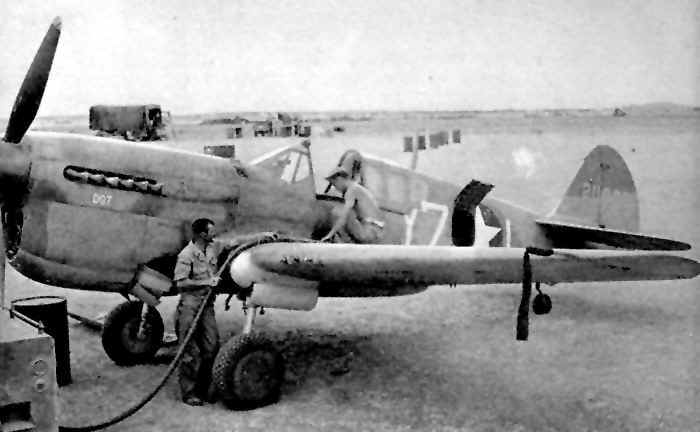
324th P-40 possibly 42-11033 (324th FG) lost Jun 15, 1944. MACR 6041, named Dot, coded Y71 which
places it with the 316th Squadron